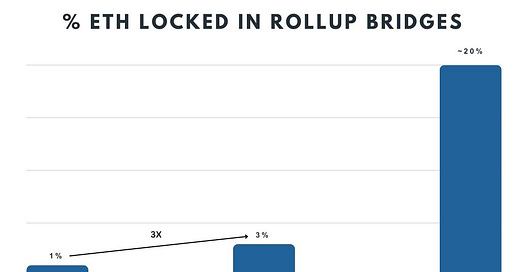Nexus Network is revolutionising rollup economics by enabling “Native Yields”
Nexus Network increases capital efficiency for rollups while also strengthening the network security of Ethereum.
Current Problem with the Rollup Economics
As of Mar ’24, 3.6 Mn ETH (~3% of the total ETH supply) is locked in rollup bridges (canonical bridges) across the Ethereum rollups. The amount of ETH locked in rollup bridges has grown exponentially over the past year, and we expect the ETH locked to reach 20% in the next 2-3 years, driven by Ethereum’s rollup-centric roadmap. This can be a problem for both Ethereum and rollups -
For Ethereum, the ETH locked does not participate in securing the chain, which is okay at current numbers, but as the amount of ETH locked grows, it can pose a significant challenge For rollups,
Capital inefficiency - ETH locked in rollup bridges is not earning any returns, leading to capital inefficiency
Some other problems that rollups face include -
Infrastructure cost - Rollups face a high cost of operations: the average cost charged by Rollup as a Service (RaaS) providers for running a rollup is USD 100k annually. This hinders the design space and experimentation with rollups as a technology
Source of revenue - Most of the rollups do not have a consistent source of revenue. The larger ones, like Optimism and Arbitrum, make good revenue from sequencer fees. However, the newer rollups do not have enough transactions to earn through sequencer fees. This impacts the sustainability of rollups and also results in large volatility in token prices because of a lack of direct value for tokens apart from governance
What are Native Yields?
Native Yield generation is the talk of the town in Ethereum land, as most of the rollups are figuring out the best way to enable yields for users. Native yields refer to yield generation on the assets locked in canonical rollup bridges on Ethereum Layer 1. Assets are locked when a user moves assets from Ethereum to any rollup. The user receives a representative token on the rollup while the actual asset is locked in a smart contract. The assets can be either ETH or stablecoins. The different ways of yield generation include -
For ETH - Staking and restaking
For Stablecoins (USDC, USDT, DAI) - Yield generation products (MakerDao DSR, Ethena, Ondo finance)
Introducing Nexus Network
Nexus Network envisions becoming the “Economic Layer for Rollups”. Using our pluggable staking infrastructure, rollups can earn revenue from the idle assets locked in the bridge contract on the Ethereum Layer 1. Rollups can stake the ETH locked in their bridges within minutes and earn a continuous stream of stable staking returns. Nexus Network leverages Distributed Validator Technology (DVT) and Distributed Key Generation (DKG) for staking. DVT minimizes validator centralization and slashing risks, and DKG ensures no single entity owns the complete validator key, hence enhancing security.
Nexus network is a completely non-custodial solution, and the Nexus contracts never get access to the rollup ETH. Other important features include -
Pluggable staking infrastructure - Rollups can integrate with Nexus Network by making small changes in their bridge contract
Customizable staking limits - Rollups can stake anywhere between 0-100% of the ETH locked in their bridge through Nexus Network. The staking limit can easily be changed by the rollup through one smart contract call
One-stop validator management - Nexus Network takes care of all the staking-related requirements, including validator selection, staking, and unstaking, monitoring, and does not put any additional responsibility on the rollup team
Inbuilt Slashing Insurance - Nexus Network provides slashing insurance to rollups in the event of validator slashing
What are the risks & how does Nexus Network solve these risks?
The following questions are pretty common when it comes to assessing risks :
What if Nexus Contracts get hacked?
Nexus Network smart contracts never take custody of the rollup assets. The deposits are either locked in the rollup bridge contract on the L1 or staked on Ethereum. Thus, even if the Nexus Network code gets compromised, nothing will change for the rollup
What if Validators/ Node Operators are slashed?
Nexus Network uses the latest in staking technology, DVT & DKG to minimize the slashing risks. Along with this, to prepare for the worst-case scenario if slashing occurs, we have brought slashing Insurance. We have partnered with industry leaders in the insurance space to insure for slashed ETH.
What if there is a bank-run scenario?
Nexus Network provides rollups the flexibility to stake anywhere between 0-100% of their bridged ETH. They can choose an X% that is optimal for their user's daily withdrawal. Changing the staking limit is just a smart contract call away.
Also, optimistic liquidity bridges like the Hop protocol allow users to instantly bridge their ETH from an Optimistic rollup to Ethereum for a small fee, bypassing the 7-day challenge window. We expect a similar market to develop where we will work with these providers as the rollup partners with them
As a start, Nexus Network has partnered with Zeeve, a leading Rollups-as-a-service (RaaS) platform that can significantly cut down on the cost of rollup deployment and recurring management, while helping rollups earn stable and sustainable staking returns with their ETH locked in L1 bridges. This strategic partnership gives Nexus Network a platform to integrate with many rollups, as Zeeve is an infrastructure leader in this space with a vast community of over 28,000 users and 40+ institutions already on the platform.
In summary, $10 Bn worth of assets (poised to become $150 Bn in 3 years) are lying idle on Rollup bridge contracts on Ethereum. Nexus Network provides a safe, secure & decentralized infrastructure to earn yields on those assets, which increases capital efficiency for rollups while also increasing the network security for Ethereum.




